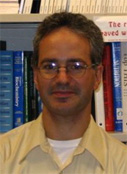
Name: Robert G. Sawyer, MD
Title: Professor of Surgery
Institution: University of Virginia
Clinical Specialty: Critical Care and transplantation
Research Interest: Healthcare Associated Infections
Webpage: http://www.hsc.virginia.edu/internet/surgery/sawyer.cfm
Institution during SIS Fellowship: University of Virginia
SIS Fellowship Mentor: Timoth Pruett, MD
SIS Fellowshp Project Title: CpG DNA and the innate immune response
Fellowship Years: 1998-2000
Fellowship Publication:
- Jin L, Raymond DP, Crabtree TD, Houlgrave CW, Pelletier SJ, Pruett TL, Sawyer RG. Enhanced murine macrophage tumor necrosis factor receptor shedding by CpG in oligodeoxynucleotides. J Immunol 2000;165:5153-5160.
How did you hear about the SIS Fellowship? From my mentor, Tim Pruett.
What did he say to you to prompt you to apply? The timing was good. This was the first year of the fellowship for junior faculty and I had just started. He thought it be worth a try since my project was quite appropriate.
Who was the main influence on your choice to become an academic surgeon? My parents.
Can you elaborate? They encouraged me to not accept the status quo and be willing to try to discover new things in difficult settings. Plus, my mother was a bacteriologist; it’s in my blood, so to speak. But I don’t have a BSI.
How did you get involved in surgical infections research? Performing CLP in rats as a fourth year student at the University of Michigan. I was working with a pediatric surgeon because I was interested in pediatric surgery.
Can you describe how the fellowship helped your career? It allowed me to be involved in the SIS. Eventually, it helped me understand the relationship between science and clinical practice.
Have you continued this line of research? Tangentially. My research is more related to the application of scientific knowledge to clinical practice.
Did you obtain further research funding in this area? Yes – in fellowship awards for trainees. Many of the early projects were basic science resident fellowship awards, including from the SIS. Later on, the projects were more clinical in nature, and the awards were from the SIS as well as individual NIH NRSA (including the first one to Heather Evans). Now we have an NIH institutional training grant in surgical infectious diseases and transplantation. I believe it is the only one like it out there.
What are your former trainees doing now? Most of my trainees are early in their academic careers, though a few are now in community practice. The good ones go to Harborview.
Can you talk a little about the transition from mentee to mentor? How did you figure out how to build a research lab? It’s interesting. The transition for mentee to mentor just kind of happened, without much planning. I started working with Dr. Pruett, then after a few years a few residents wanted to start working with me as their mentor. The resident trainees definitely were the prime movers of expanding my research efforts; they were the ones that had all of the good ideas and gave me the motivation to try new and different things.
What would you tell medical students who are interested in surgery? Only do it if you love it. It’s not a good field for the half-committed.
What suggestions would you give to residents who would like to pursue research projects? Funding? Find an area you will love even during the down times, then be persistent.
How did you first get involved in the Surgical Infection Society? I went to a meeting in 1989. It was very intimidating and scientific. About half of the papers were about TNF. I remember meeting Tim Billiar, John Mazuski, Richard Simmons, and a lot of the people who had worked with Tim Pruett in Minnesota. Most of all, though, I remember meeting a lot of really fun Canadians, including Ori Rotstein, John Marshall, and Nick Christou. They took me out to dinner and kind of took me in like an orphan.
Anything else? The SIS is a unique society unlike any other in surgery.
How so? Why should young investigators get involved in SIS? First, it’s a mix of basic and clinical science. Second, pretty much everyone is dedicated to the field and really on top of things. Third, the meeting is just about the right size and it helps that it is in one hotel. It is very easy to ask presenters questions before or after they speak. You are bound to run into them in the lobby. Fourth, they’ve been on a good run of locations. South Beach, La Jolla, Hilton Head. The closer to the beach, the better.